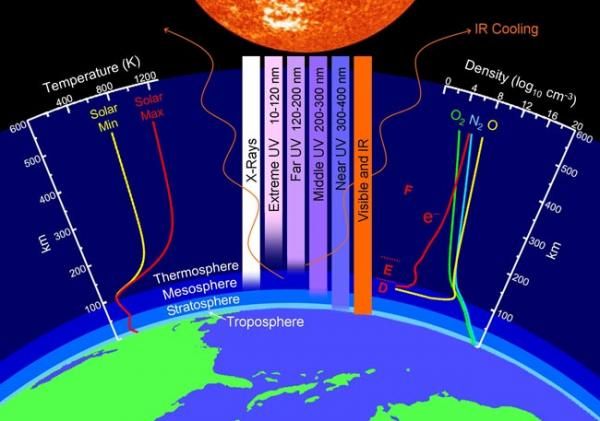
Sun's Fluctuations Caused Partial Collapse of Earth's Atmosphere

As the sun's energy rises and falls, so goes the Earth's atmosphere, a new study suggests.
These fluctuations in the sun's energy explain a recent collapse of the Earth's upper atmosphere, which had previously puzzled scientists.
A sharp drop in the Sun's ultraviolet radiation levels triggered the collapse, according to the new study, detailed in the Aug. 25 edition of the journal Geophysical Research Letters. The researchers also found that the sun's magnetic cycle, which produces differing numbers of sunspots over an approximately 11-year cycle, may vary more than previously thought.
"Our work demonstrates that the solar cycle not only varies on the typical 11-year time scale, but also can vary from one solar minimum to another," said study team member Stanley Solomon of the National Center for Atmospheric Research (NCAR) in Boulder, Colo. "All solar minima are not equal."
The findings may have implications for orbiting satellites, as well as for the International Space Station.
During a collapse, the fact that the layer in the upper atmosphere known as the thermosphere is shrunken and less dense means that satellites can more easily maintain their orbits. But it also indicates that space debris and other objects that pose hazards may persist longer in the thermosphere. [Graphic: Earth's Atmosphere Top to Bottom ]
"With lower thermospheric density, our satellites will have a longer life in orbit," said study team member Thomas Woods of the University of Colorado at Boulder. "This is good news for those satellites that are actually operating, but it is also bad because of the thousands of non-operating objects remaining in space that could potentially have collisions with our working satellites."
Sign up for the Live Science daily newsletter now
Get the world’s most fascinating discoveries delivered straight to your inbox.
Greater than expected change
Recently, solar activity was at an extreme low. In 2008 and 2009, sunspots were scarce, solar flares almost non-existent, and solar extreme ultraviolet light (EUV) a class of photons with extremely short wavelengths was at a low ebb.
During this time, the Earth's thermosphere shrank more than at any time in the 43-year era of space exploration.
The thermosphere, which ranges in altitude from about 55 to more than 300 miles (90-500 km), is a rarified layer of gas at the edge of space where the Sun's radiation first makes contact with Earth's atmosphere. It typically cools and becomes less dense during low solar activity.
But the magnitude of the density change during the recent solar minimum appeared to be about 30 percent greater than would have been expected by low solar activity.
Radiation or carbon dioxide?
Researchers used computer models to analyze two possible culprits in the mystery of the shrinking thermosphere.
They simulated both the impacts of the sun's output and the role of carbon dioxide, a potent greenhouse gas that, according to past estimates, is reducing the density of the outer atmosphere by about 2 percent to 5 percent per decade.
However, scientists were uncertain whether the decline in extreme-ultraviolet radiation would be sufficient to have such a dramatic impact on the thermosphere, even when combined with the effects of carbon dioxide.
The computer models showed that the thermosphere cooled in 2008 by 41 Kelvins (about 74 degrees Fahrenheit or 41 degrees Celsius) compared to 1996, with just 2 Kelvins attributable to the carbon dioxide increase.
The results also showed the thermosphere's density decreasing by 31 percent, with just 3 percent attributable to carbon dioxide. The results closely approximated the 30 percent reduction in density indicated by previous work.
"It is now clear that the record low temperature and density were primarily caused by unusually low levels of solar radiation at the extreme-ultraviolet level," Solomon said.
Woods says the research indicates that the Sun could be going through a period of relatively low activity, similar to periods in the early 19th and 20th centuries. This could mean that solar output may remain at a low level for the near future.
"If it is indeed similar to certain patterns in the past, then we expect to have low solar cycles for the next 10 to 30 years," Woods said.
This article was provided by SPACE.com, a sister site to OurAmazingPlanet.












